Project Management: Case Studies and References
VerifiedAdded on 2021/04/19
|13
|2975
|436
AI Summary
This assignment involves a comprehensive analysis of project management case studies, references, and tools. It requires an examination of various projects' successes and failures, as well as the implementation of project financial management strategies. The purpose is to identify best practices, challenges, and improvements in project management, utilizing references from academic journals and books.
Contribute Materials
Your contribution can guide someone’s learning journey. Share your
documents today.
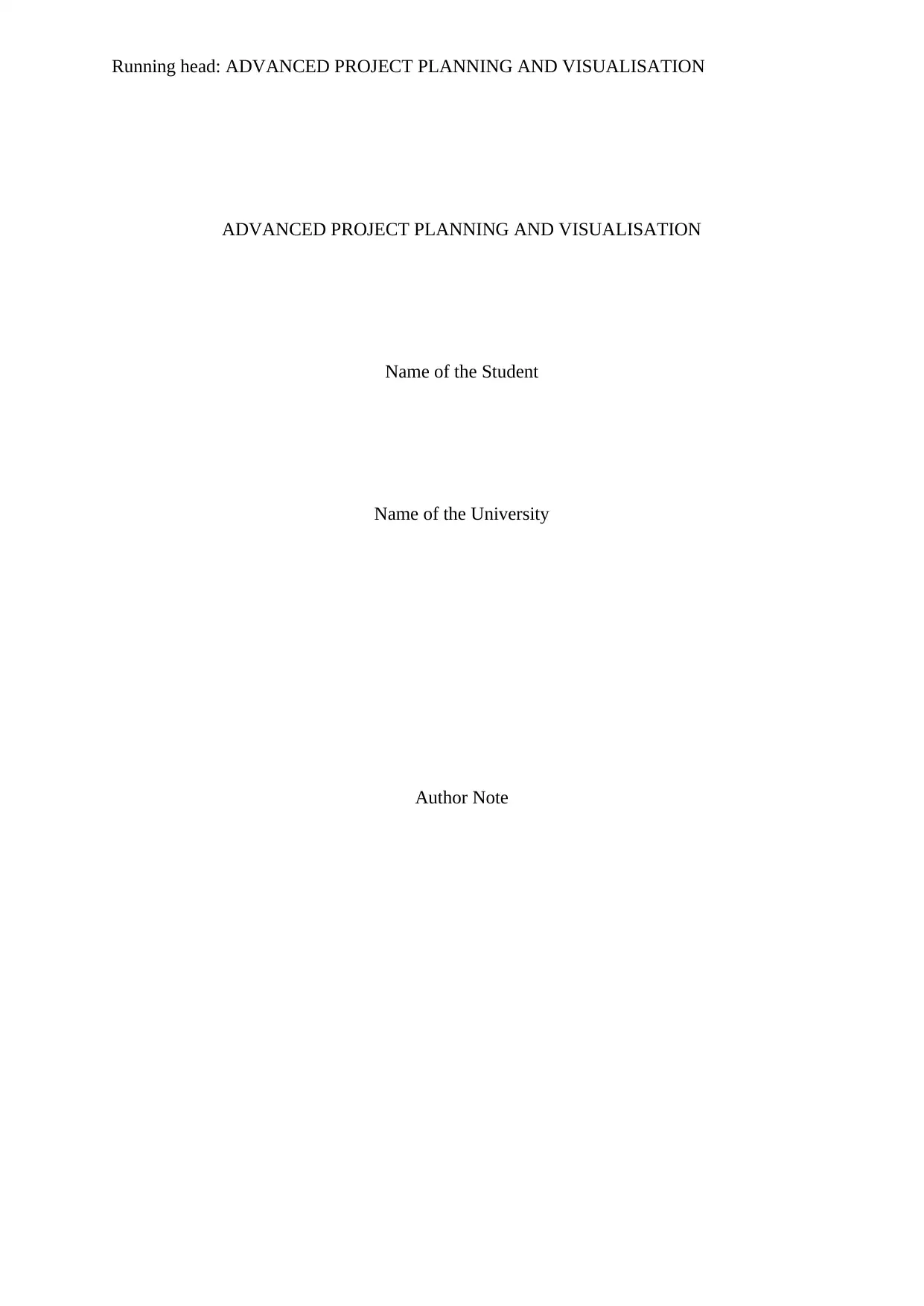
Running head: ADVANCED PROJECT PLANNING AND VISUALISATION
ADVANCED PROJECT PLANNING AND VISUALISATION
Name of the Student
Name of the University
Author Note
ADVANCED PROJECT PLANNING AND VISUALISATION
Name of the Student
Name of the University
Author Note
Secure Best Marks with AI Grader
Need help grading? Try our AI Grader for instant feedback on your assignments.
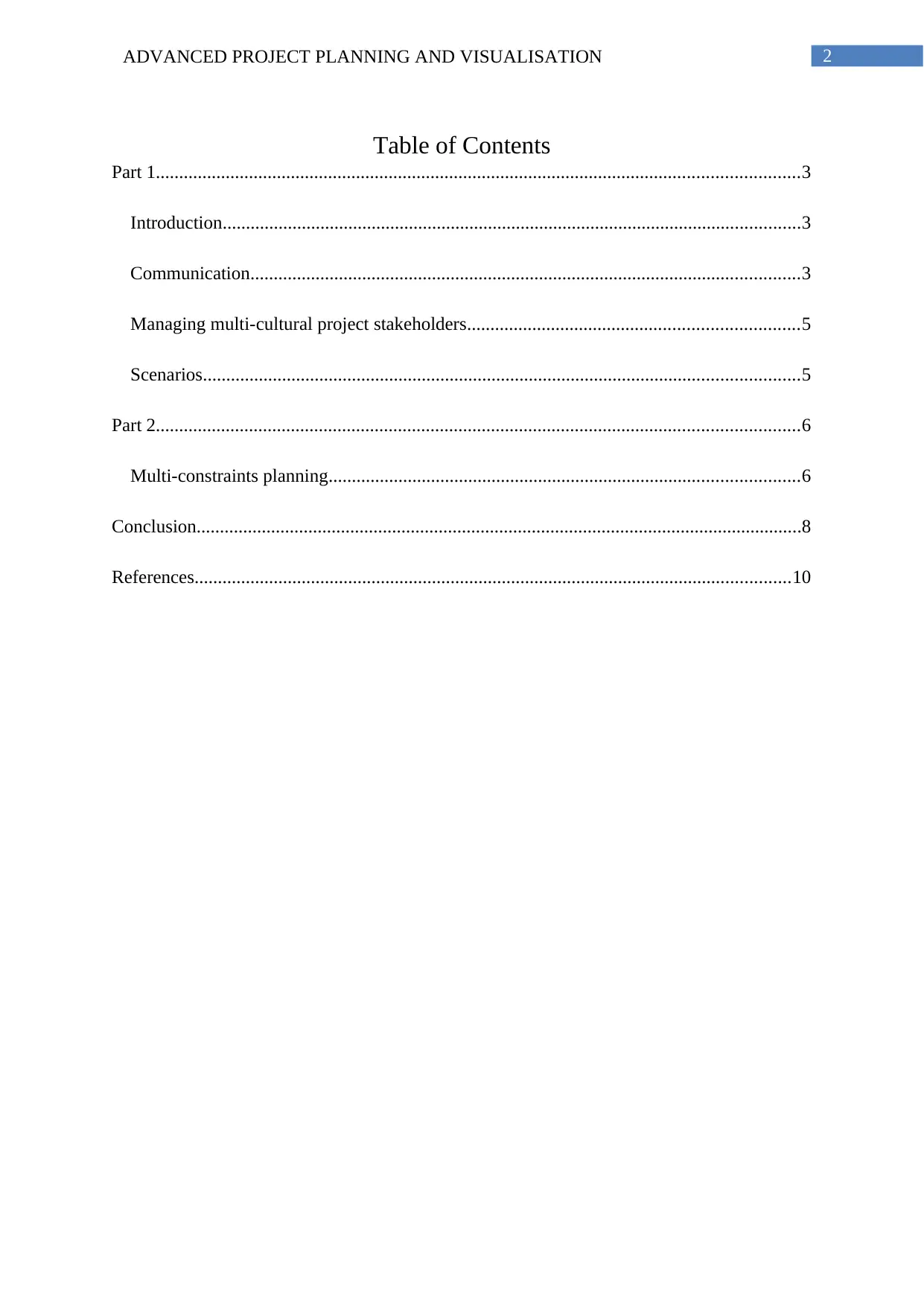
2ADVANCED PROJECT PLANNING AND VISUALISATION
Table of Contents
Part 1..........................................................................................................................................3
Introduction............................................................................................................................3
Communication......................................................................................................................3
Managing multi-cultural project stakeholders.......................................................................5
Scenarios................................................................................................................................5
Part 2..........................................................................................................................................6
Multi-constraints planning.....................................................................................................6
Conclusion..................................................................................................................................8
References................................................................................................................................10
Table of Contents
Part 1..........................................................................................................................................3
Introduction............................................................................................................................3
Communication......................................................................................................................3
Managing multi-cultural project stakeholders.......................................................................5
Scenarios................................................................................................................................5
Part 2..........................................................................................................................................6
Multi-constraints planning.....................................................................................................6
Conclusion..................................................................................................................................8
References................................................................................................................................10
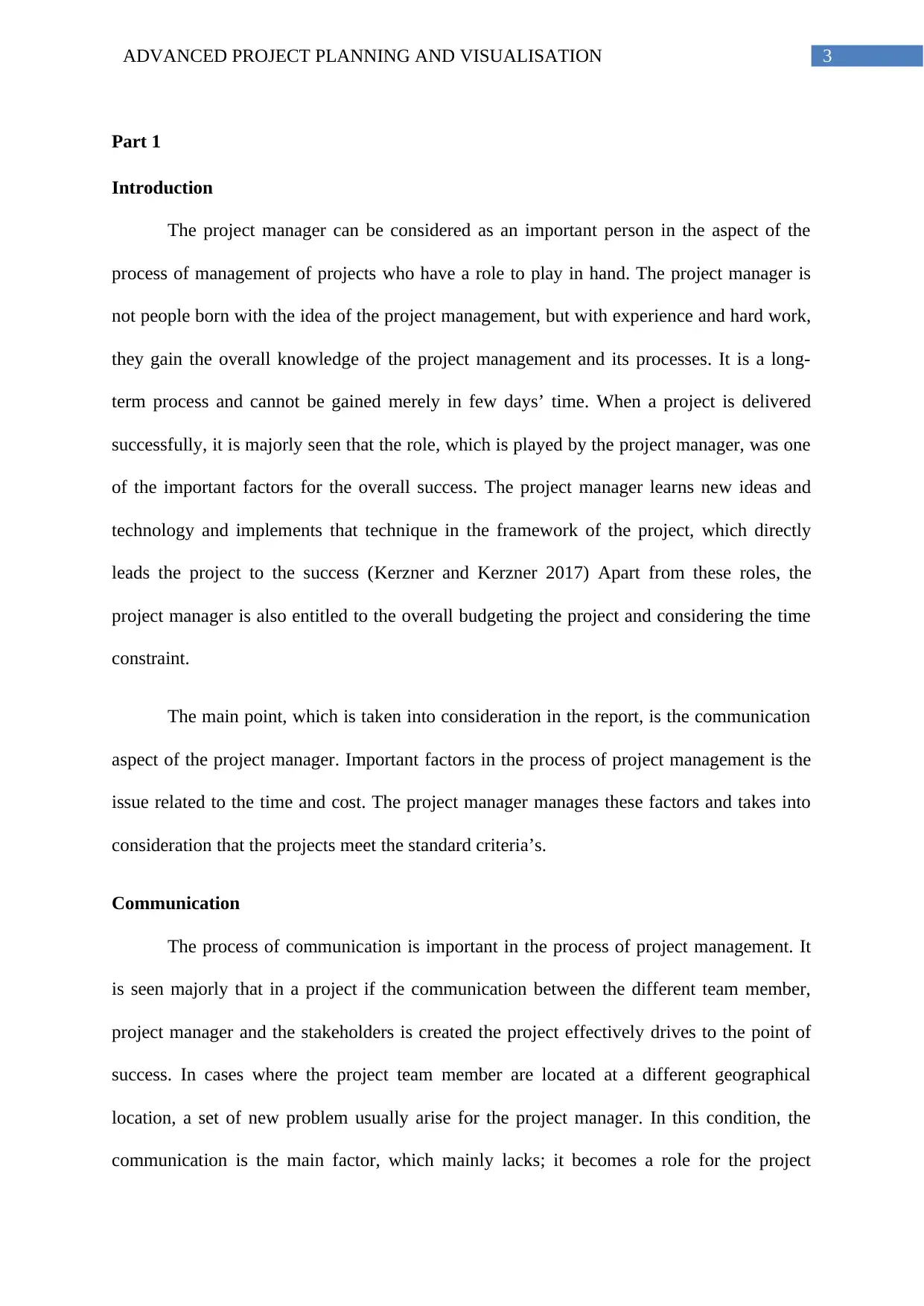
3ADVANCED PROJECT PLANNING AND VISUALISATION
Part 1
Introduction
The project manager can be considered as an important person in the aspect of the
process of management of projects who have a role to play in hand. The project manager is
not people born with the idea of the project management, but with experience and hard work,
they gain the overall knowledge of the project management and its processes. It is a long-
term process and cannot be gained merely in few days’ time. When a project is delivered
successfully, it is majorly seen that the role, which is played by the project manager, was one
of the important factors for the overall success. The project manager learns new ideas and
technology and implements that technique in the framework of the project, which directly
leads the project to the success (Kerzner and Kerzner 2017) Apart from these roles, the
project manager is also entitled to the overall budgeting the project and considering the time
constraint.
The main point, which is taken into consideration in the report, is the communication
aspect of the project manager. Important factors in the process of project management is the
issue related to the time and cost. The project manager manages these factors and takes into
consideration that the projects meet the standard criteria’s.
Communication
The process of communication is important in the process of project management. It
is seen majorly that in a project if the communication between the different team member,
project manager and the stakeholders is created the project effectively drives to the point of
success. In cases where the project team member are located at a different geographical
location, a set of new problem usually arise for the project manager. In this condition, the
communication is the main factor, which mainly lacks; it becomes a role for the project
Part 1
Introduction
The project manager can be considered as an important person in the aspect of the
process of management of projects who have a role to play in hand. The project manager is
not people born with the idea of the project management, but with experience and hard work,
they gain the overall knowledge of the project management and its processes. It is a long-
term process and cannot be gained merely in few days’ time. When a project is delivered
successfully, it is majorly seen that the role, which is played by the project manager, was one
of the important factors for the overall success. The project manager learns new ideas and
technology and implements that technique in the framework of the project, which directly
leads the project to the success (Kerzner and Kerzner 2017) Apart from these roles, the
project manager is also entitled to the overall budgeting the project and considering the time
constraint.
The main point, which is taken into consideration in the report, is the communication
aspect of the project manager. Important factors in the process of project management is the
issue related to the time and cost. The project manager manages these factors and takes into
consideration that the projects meet the standard criteria’s.
Communication
The process of communication is important in the process of project management. It
is seen majorly that in a project if the communication between the different team member,
project manager and the stakeholders is created the project effectively drives to the point of
success. In cases where the project team member are located at a different geographical
location, a set of new problem usually arise for the project manager. In this condition, the
communication is the main factor, which mainly lacks; it becomes a role for the project
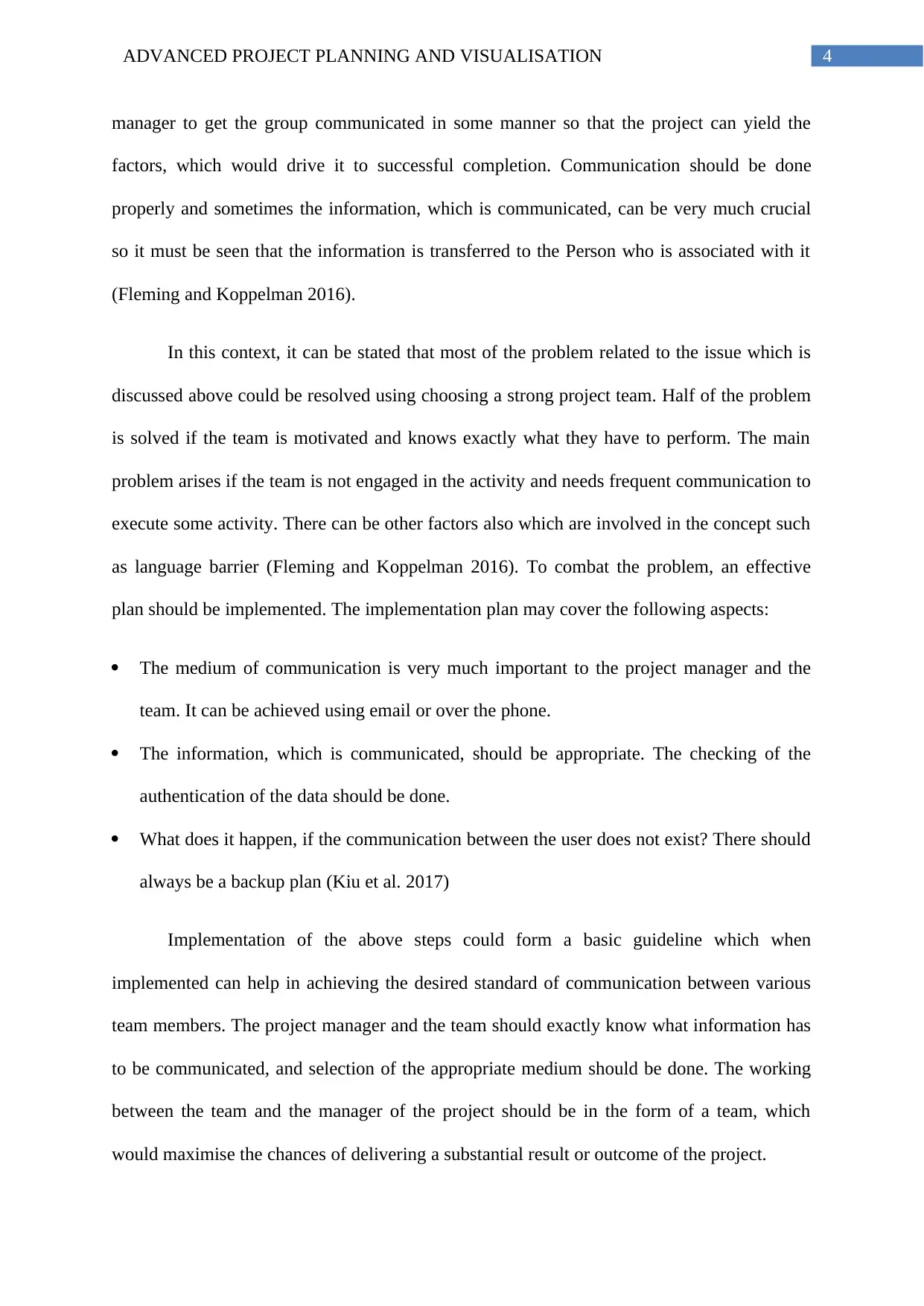
4ADVANCED PROJECT PLANNING AND VISUALISATION
manager to get the group communicated in some manner so that the project can yield the
factors, which would drive it to successful completion. Communication should be done
properly and sometimes the information, which is communicated, can be very much crucial
so it must be seen that the information is transferred to the Person who is associated with it
(Fleming and Koppelman 2016).
In this context, it can be stated that most of the problem related to the issue which is
discussed above could be resolved using choosing a strong project team. Half of the problem
is solved if the team is motivated and knows exactly what they have to perform. The main
problem arises if the team is not engaged in the activity and needs frequent communication to
execute some activity. There can be other factors also which are involved in the concept such
as language barrier (Fleming and Koppelman 2016). To combat the problem, an effective
plan should be implemented. The implementation plan may cover the following aspects:
The medium of communication is very much important to the project manager and the
team. It can be achieved using email or over the phone.
The information, which is communicated, should be appropriate. The checking of the
authentication of the data should be done.
What does it happen, if the communication between the user does not exist? There should
always be a backup plan (Kiu et al. 2017)
Implementation of the above steps could form a basic guideline which when
implemented can help in achieving the desired standard of communication between various
team members. The project manager and the team should exactly know what information has
to be communicated, and selection of the appropriate medium should be done. The working
between the team and the manager of the project should be in the form of a team, which
would maximise the chances of delivering a substantial result or outcome of the project.
manager to get the group communicated in some manner so that the project can yield the
factors, which would drive it to successful completion. Communication should be done
properly and sometimes the information, which is communicated, can be very much crucial
so it must be seen that the information is transferred to the Person who is associated with it
(Fleming and Koppelman 2016).
In this context, it can be stated that most of the problem related to the issue which is
discussed above could be resolved using choosing a strong project team. Half of the problem
is solved if the team is motivated and knows exactly what they have to perform. The main
problem arises if the team is not engaged in the activity and needs frequent communication to
execute some activity. There can be other factors also which are involved in the concept such
as language barrier (Fleming and Koppelman 2016). To combat the problem, an effective
plan should be implemented. The implementation plan may cover the following aspects:
The medium of communication is very much important to the project manager and the
team. It can be achieved using email or over the phone.
The information, which is communicated, should be appropriate. The checking of the
authentication of the data should be done.
What does it happen, if the communication between the user does not exist? There should
always be a backup plan (Kiu et al. 2017)
Implementation of the above steps could form a basic guideline which when
implemented can help in achieving the desired standard of communication between various
team members. The project manager and the team should exactly know what information has
to be communicated, and selection of the appropriate medium should be done. The working
between the team and the manager of the project should be in the form of a team, which
would maximise the chances of delivering a substantial result or outcome of the project.
Secure Best Marks with AI Grader
Need help grading? Try our AI Grader for instant feedback on your assignments.
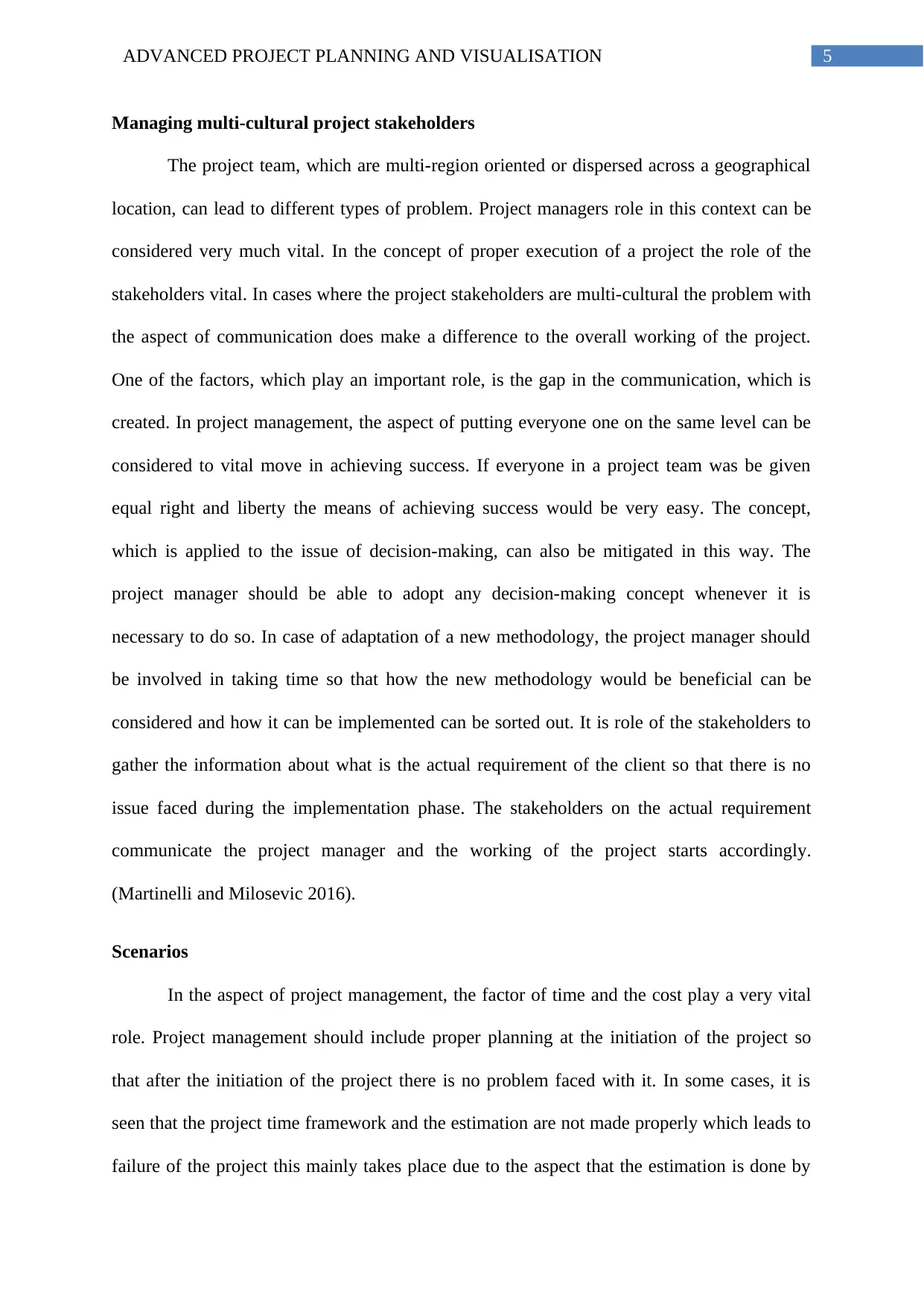
5ADVANCED PROJECT PLANNING AND VISUALISATION
Managing multi-cultural project stakeholders
The project team, which are multi-region oriented or dispersed across a geographical
location, can lead to different types of problem. Project managers role in this context can be
considered very much vital. In the concept of proper execution of a project the role of the
stakeholders vital. In cases where the project stakeholders are multi-cultural the problem with
the aspect of communication does make a difference to the overall working of the project.
One of the factors, which play an important role, is the gap in the communication, which is
created. In project management, the aspect of putting everyone one on the same level can be
considered to vital move in achieving success. If everyone in a project team was be given
equal right and liberty the means of achieving success would be very easy. The concept,
which is applied to the issue of decision-making, can also be mitigated in this way. The
project manager should be able to adopt any decision-making concept whenever it is
necessary to do so. In case of adaptation of a new methodology, the project manager should
be involved in taking time so that how the new methodology would be beneficial can be
considered and how it can be implemented can be sorted out. It is role of the stakeholders to
gather the information about what is the actual requirement of the client so that there is no
issue faced during the implementation phase. The stakeholders on the actual requirement
communicate the project manager and the working of the project starts accordingly.
(Martinelli and Milosevic 2016).
Scenarios
In the aspect of project management, the factor of time and the cost play a very vital
role. Project management should include proper planning at the initiation of the project so
that after the initiation of the project there is no problem faced with it. In some cases, it is
seen that the project time framework and the estimation are not made properly which leads to
failure of the project this mainly takes place due to the aspect that the estimation is done by
Managing multi-cultural project stakeholders
The project team, which are multi-region oriented or dispersed across a geographical
location, can lead to different types of problem. Project managers role in this context can be
considered very much vital. In the concept of proper execution of a project the role of the
stakeholders vital. In cases where the project stakeholders are multi-cultural the problem with
the aspect of communication does make a difference to the overall working of the project.
One of the factors, which play an important role, is the gap in the communication, which is
created. In project management, the aspect of putting everyone one on the same level can be
considered to vital move in achieving success. If everyone in a project team was be given
equal right and liberty the means of achieving success would be very easy. The concept,
which is applied to the issue of decision-making, can also be mitigated in this way. The
project manager should be able to adopt any decision-making concept whenever it is
necessary to do so. In case of adaptation of a new methodology, the project manager should
be involved in taking time so that how the new methodology would be beneficial can be
considered and how it can be implemented can be sorted out. It is role of the stakeholders to
gather the information about what is the actual requirement of the client so that there is no
issue faced during the implementation phase. The stakeholders on the actual requirement
communicate the project manager and the working of the project starts accordingly.
(Martinelli and Milosevic 2016).
Scenarios
In the aspect of project management, the factor of time and the cost play a very vital
role. Project management should include proper planning at the initiation of the project so
that after the initiation of the project there is no problem faced with it. In some cases, it is
seen that the project time framework and the estimation are not made properly which leads to
failure of the project this mainly takes place due to the aspect that the estimation is done by
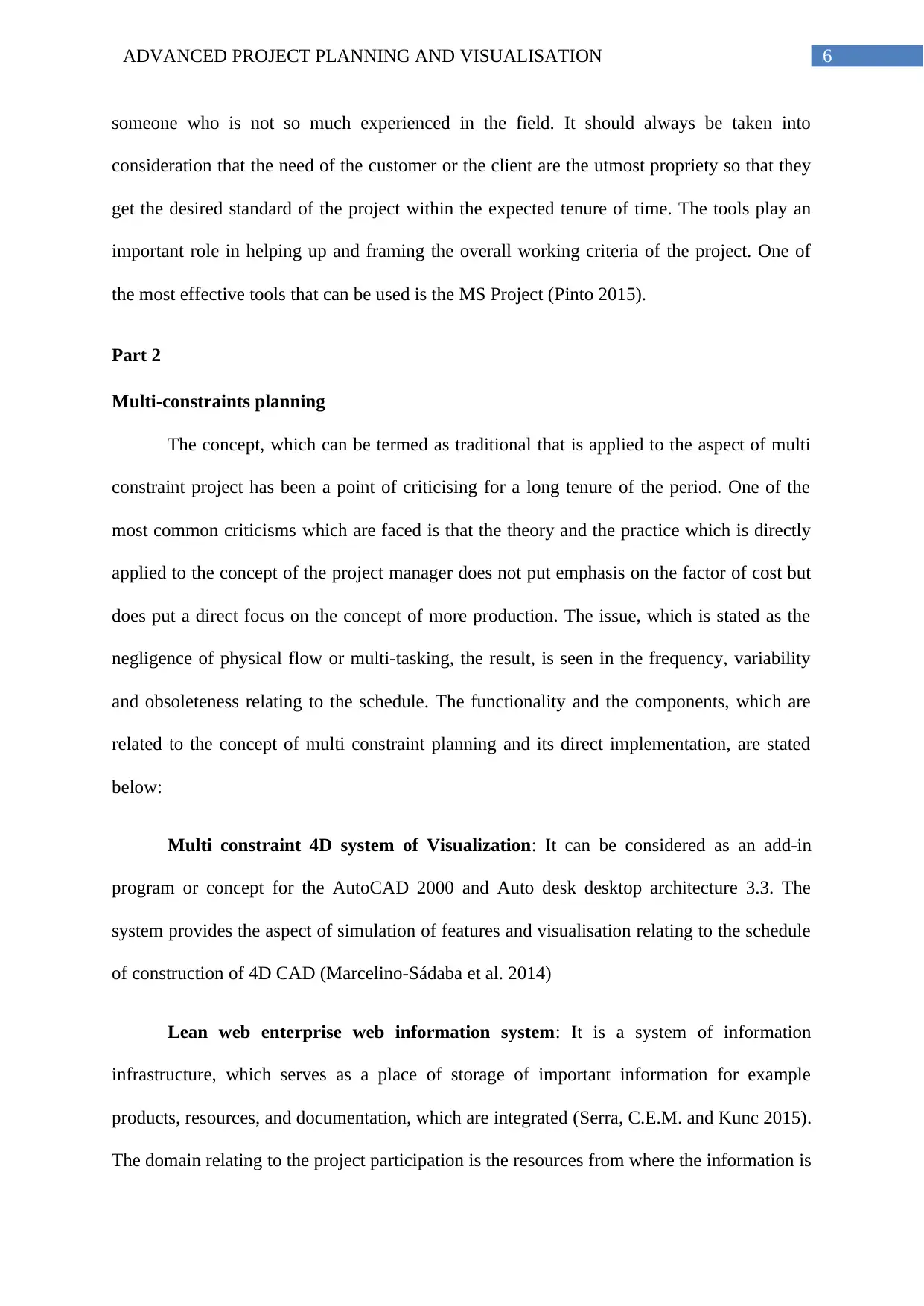
6ADVANCED PROJECT PLANNING AND VISUALISATION
someone who is not so much experienced in the field. It should always be taken into
consideration that the need of the customer or the client are the utmost propriety so that they
get the desired standard of the project within the expected tenure of time. The tools play an
important role in helping up and framing the overall working criteria of the project. One of
the most effective tools that can be used is the MS Project (Pinto 2015).
Part 2
Multi-constraints planning
The concept, which can be termed as traditional that is applied to the aspect of multi
constraint project has been a point of criticising for a long tenure of the period. One of the
most common criticisms which are faced is that the theory and the practice which is directly
applied to the concept of the project manager does not put emphasis on the factor of cost but
does put a direct focus on the concept of more production. The issue, which is stated as the
negligence of physical flow or multi-tasking, the result, is seen in the frequency, variability
and obsoleteness relating to the schedule. The functionality and the components, which are
related to the concept of multi constraint planning and its direct implementation, are stated
below:
Multi constraint 4D system of Visualization: It can be considered as an add-in
program or concept for the AutoCAD 2000 and Auto desk desktop architecture 3.3. The
system provides the aspect of simulation of features and visualisation relating to the schedule
of construction of 4D CAD (Marcelino-Sádaba et al. 2014)
Lean web enterprise web information system: It is a system of information
infrastructure, which serves as a place of storage of important information for example
products, resources, and documentation, which are integrated (Serra, C.E.M. and Kunc 2015).
The domain relating to the project participation is the resources from where the information is
someone who is not so much experienced in the field. It should always be taken into
consideration that the need of the customer or the client are the utmost propriety so that they
get the desired standard of the project within the expected tenure of time. The tools play an
important role in helping up and framing the overall working criteria of the project. One of
the most effective tools that can be used is the MS Project (Pinto 2015).
Part 2
Multi-constraints planning
The concept, which can be termed as traditional that is applied to the aspect of multi
constraint project has been a point of criticising for a long tenure of the period. One of the
most common criticisms which are faced is that the theory and the practice which is directly
applied to the concept of the project manager does not put emphasis on the factor of cost but
does put a direct focus on the concept of more production. The issue, which is stated as the
negligence of physical flow or multi-tasking, the result, is seen in the frequency, variability
and obsoleteness relating to the schedule. The functionality and the components, which are
related to the concept of multi constraint planning and its direct implementation, are stated
below:
Multi constraint 4D system of Visualization: It can be considered as an add-in
program or concept for the AutoCAD 2000 and Auto desk desktop architecture 3.3. The
system provides the aspect of simulation of features and visualisation relating to the schedule
of construction of 4D CAD (Marcelino-Sádaba et al. 2014)
Lean web enterprise web information system: It is a system of information
infrastructure, which serves as a place of storage of important information for example
products, resources, and documentation, which are integrated (Serra, C.E.M. and Kunc 2015).
The domain relating to the project participation is the resources from where the information is
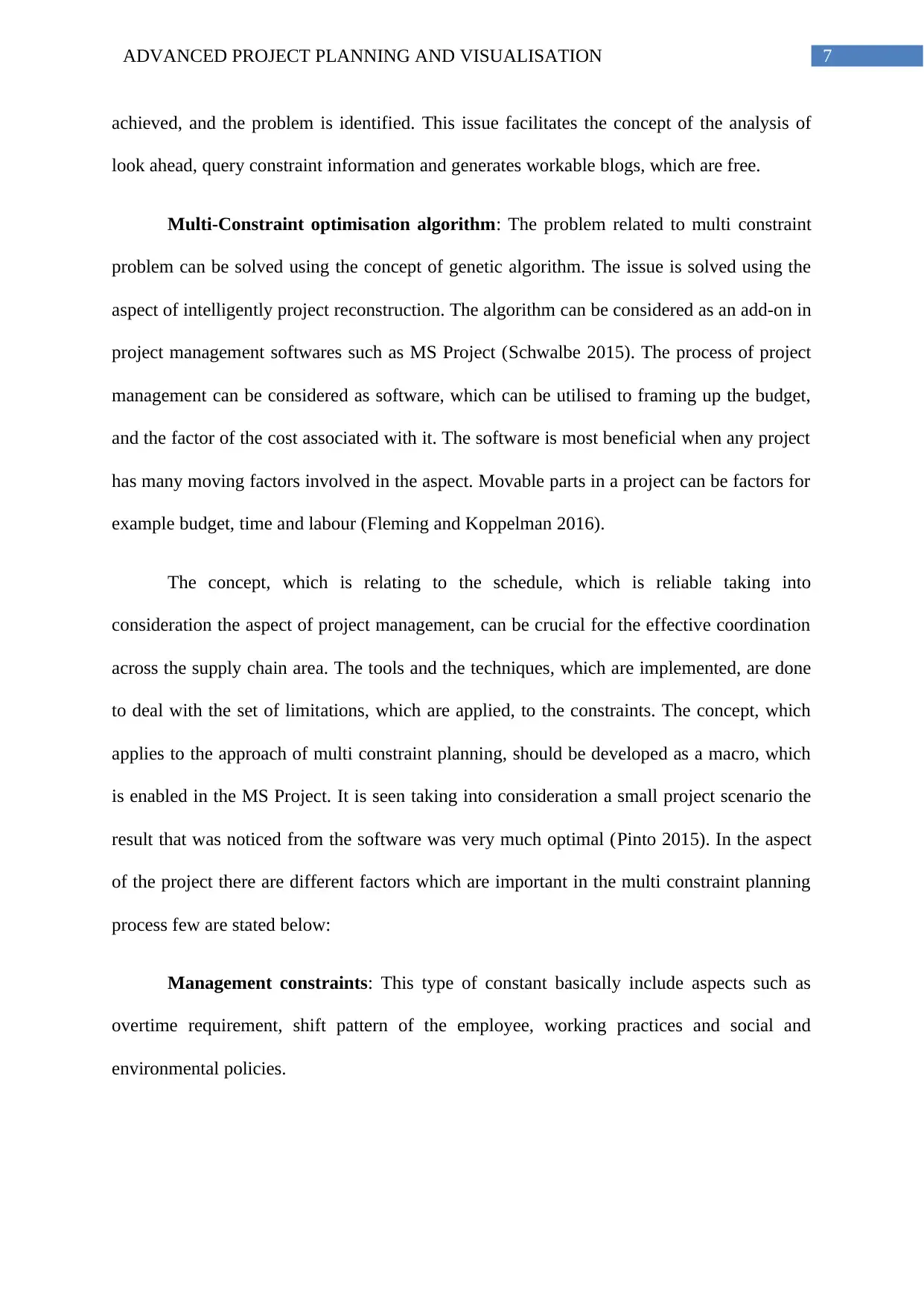
7ADVANCED PROJECT PLANNING AND VISUALISATION
achieved, and the problem is identified. This issue facilitates the concept of the analysis of
look ahead, query constraint information and generates workable blogs, which are free.
Multi-Constraint optimisation algorithm: The problem related to multi constraint
problem can be solved using the concept of genetic algorithm. The issue is solved using the
aspect of intelligently project reconstruction. The algorithm can be considered as an add-on in
project management softwares such as MS Project (Schwalbe 2015). The process of project
management can be considered as software, which can be utilised to framing up the budget,
and the factor of the cost associated with it. The software is most beneficial when any project
has many moving factors involved in the aspect. Movable parts in a project can be factors for
example budget, time and labour (Fleming and Koppelman 2016).
The concept, which is relating to the schedule, which is reliable taking into
consideration the aspect of project management, can be crucial for the effective coordination
across the supply chain area. The tools and the techniques, which are implemented, are done
to deal with the set of limitations, which are applied, to the constraints. The concept, which
applies to the approach of multi constraint planning, should be developed as a macro, which
is enabled in the MS Project. It is seen taking into consideration a small project scenario the
result that was noticed from the software was very much optimal (Pinto 2015). In the aspect
of the project there are different factors which are important in the multi constraint planning
process few are stated below:
Management constraints: This type of constant basically include aspects such as
overtime requirement, shift pattern of the employee, working practices and social and
environmental policies.
achieved, and the problem is identified. This issue facilitates the concept of the analysis of
look ahead, query constraint information and generates workable blogs, which are free.
Multi-Constraint optimisation algorithm: The problem related to multi constraint
problem can be solved using the concept of genetic algorithm. The issue is solved using the
aspect of intelligently project reconstruction. The algorithm can be considered as an add-on in
project management softwares such as MS Project (Schwalbe 2015). The process of project
management can be considered as software, which can be utilised to framing up the budget,
and the factor of the cost associated with it. The software is most beneficial when any project
has many moving factors involved in the aspect. Movable parts in a project can be factors for
example budget, time and labour (Fleming and Koppelman 2016).
The concept, which is relating to the schedule, which is reliable taking into
consideration the aspect of project management, can be crucial for the effective coordination
across the supply chain area. The tools and the techniques, which are implemented, are done
to deal with the set of limitations, which are applied, to the constraints. The concept, which
applies to the approach of multi constraint planning, should be developed as a macro, which
is enabled in the MS Project. It is seen taking into consideration a small project scenario the
result that was noticed from the software was very much optimal (Pinto 2015). In the aspect
of the project there are different factors which are important in the multi constraint planning
process few are stated below:
Management constraints: This type of constant basically include aspects such as
overtime requirement, shift pattern of the employee, working practices and social and
environmental policies.
Paraphrase This Document
Need a fresh take? Get an instant paraphrase of this document with our AI Paraphraser
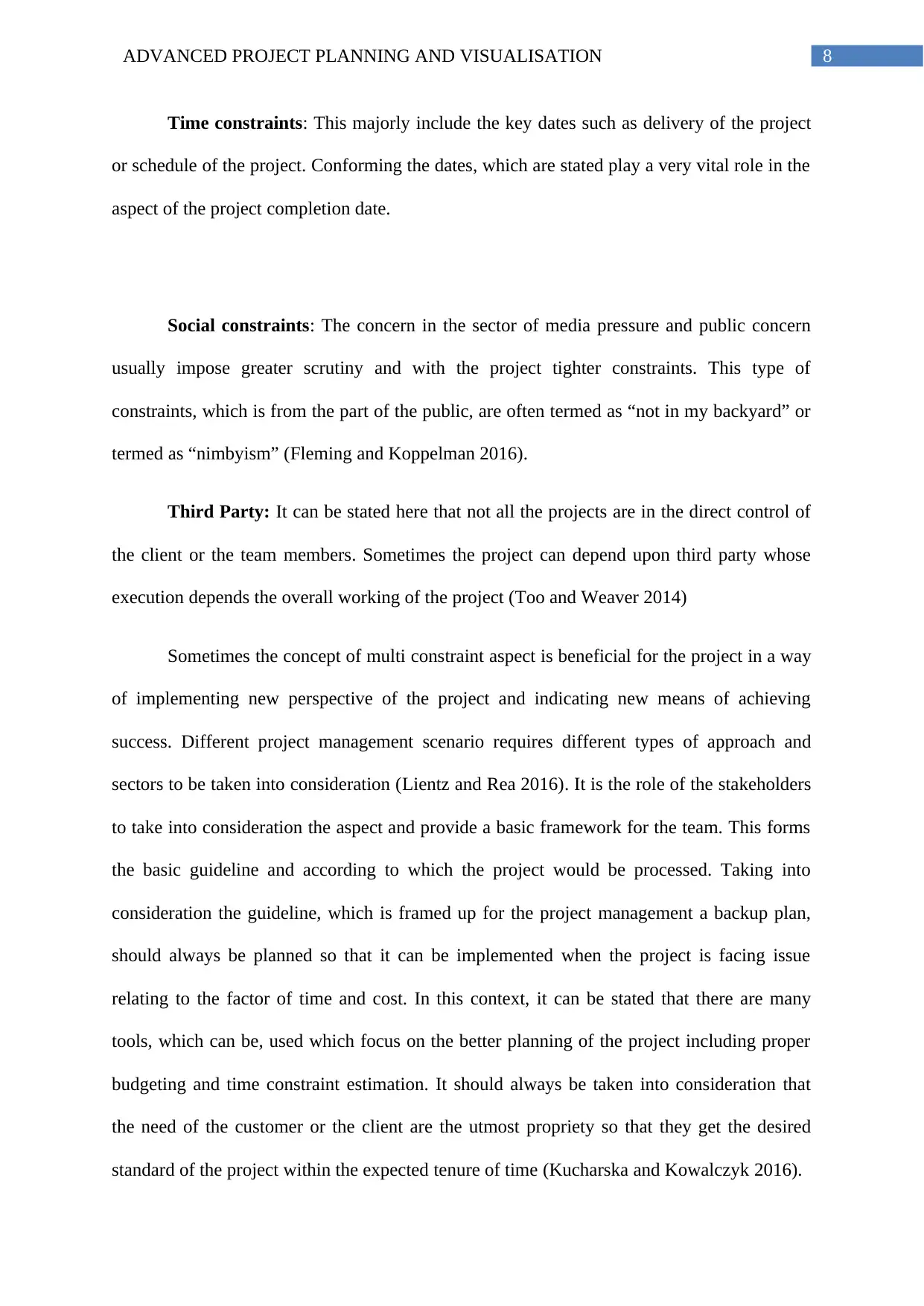
8ADVANCED PROJECT PLANNING AND VISUALISATION
Time constraints: This majorly include the key dates such as delivery of the project
or schedule of the project. Conforming the dates, which are stated play a very vital role in the
aspect of the project completion date.
Social constraints: The concern in the sector of media pressure and public concern
usually impose greater scrutiny and with the project tighter constraints. This type of
constraints, which is from the part of the public, are often termed as “not in my backyard” or
termed as “nimbyism” (Fleming and Koppelman 2016).
Third Party: It can be stated here that not all the projects are in the direct control of
the client or the team members. Sometimes the project can depend upon third party whose
execution depends the overall working of the project (Too and Weaver 2014)
Sometimes the concept of multi constraint aspect is beneficial for the project in a way
of implementing new perspective of the project and indicating new means of achieving
success. Different project management scenario requires different types of approach and
sectors to be taken into consideration (Lientz and Rea 2016). It is the role of the stakeholders
to take into consideration the aspect and provide a basic framework for the team. This forms
the basic guideline and according to which the project would be processed. Taking into
consideration the guideline, which is framed up for the project management a backup plan,
should always be planned so that it can be implemented when the project is facing issue
relating to the factor of time and cost. In this context, it can be stated that there are many
tools, which can be, used which focus on the better planning of the project including proper
budgeting and time constraint estimation. It should always be taken into consideration that
the need of the customer or the client are the utmost propriety so that they get the desired
standard of the project within the expected tenure of time (Kucharska and Kowalczyk 2016).
Time constraints: This majorly include the key dates such as delivery of the project
or schedule of the project. Conforming the dates, which are stated play a very vital role in the
aspect of the project completion date.
Social constraints: The concern in the sector of media pressure and public concern
usually impose greater scrutiny and with the project tighter constraints. This type of
constraints, which is from the part of the public, are often termed as “not in my backyard” or
termed as “nimbyism” (Fleming and Koppelman 2016).
Third Party: It can be stated here that not all the projects are in the direct control of
the client or the team members. Sometimes the project can depend upon third party whose
execution depends the overall working of the project (Too and Weaver 2014)
Sometimes the concept of multi constraint aspect is beneficial for the project in a way
of implementing new perspective of the project and indicating new means of achieving
success. Different project management scenario requires different types of approach and
sectors to be taken into consideration (Lientz and Rea 2016). It is the role of the stakeholders
to take into consideration the aspect and provide a basic framework for the team. This forms
the basic guideline and according to which the project would be processed. Taking into
consideration the guideline, which is framed up for the project management a backup plan,
should always be planned so that it can be implemented when the project is facing issue
relating to the factor of time and cost. In this context, it can be stated that there are many
tools, which can be, used which focus on the better planning of the project including proper
budgeting and time constraint estimation. It should always be taken into consideration that
the need of the customer or the client are the utmost propriety so that they get the desired
standard of the project within the expected tenure of time (Kucharska and Kowalczyk 2016).
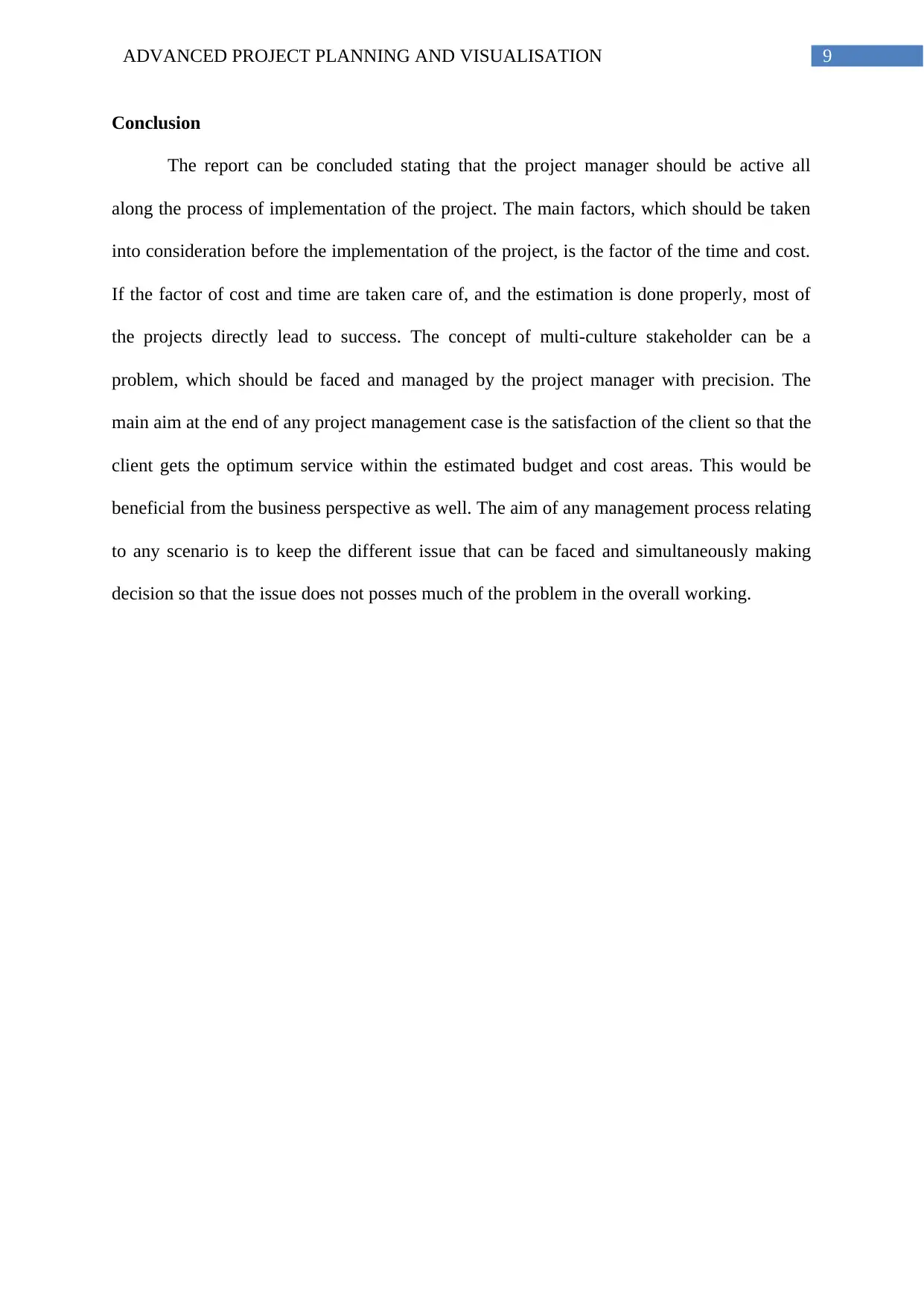
9ADVANCED PROJECT PLANNING AND VISUALISATION
Conclusion
The report can be concluded stating that the project manager should be active all
along the process of implementation of the project. The main factors, which should be taken
into consideration before the implementation of the project, is the factor of the time and cost.
If the factor of cost and time are taken care of, and the estimation is done properly, most of
the projects directly lead to success. The concept of multi-culture stakeholder can be a
problem, which should be faced and managed by the project manager with precision. The
main aim at the end of any project management case is the satisfaction of the client so that the
client gets the optimum service within the estimated budget and cost areas. This would be
beneficial from the business perspective as well. The aim of any management process relating
to any scenario is to keep the different issue that can be faced and simultaneously making
decision so that the issue does not posses much of the problem in the overall working.
Conclusion
The report can be concluded stating that the project manager should be active all
along the process of implementation of the project. The main factors, which should be taken
into consideration before the implementation of the project, is the factor of the time and cost.
If the factor of cost and time are taken care of, and the estimation is done properly, most of
the projects directly lead to success. The concept of multi-culture stakeholder can be a
problem, which should be faced and managed by the project manager with precision. The
main aim at the end of any project management case is the satisfaction of the client so that the
client gets the optimum service within the estimated budget and cost areas. This would be
beneficial from the business perspective as well. The aim of any management process relating
to any scenario is to keep the different issue that can be faced and simultaneously making
decision so that the issue does not posses much of the problem in the overall working.
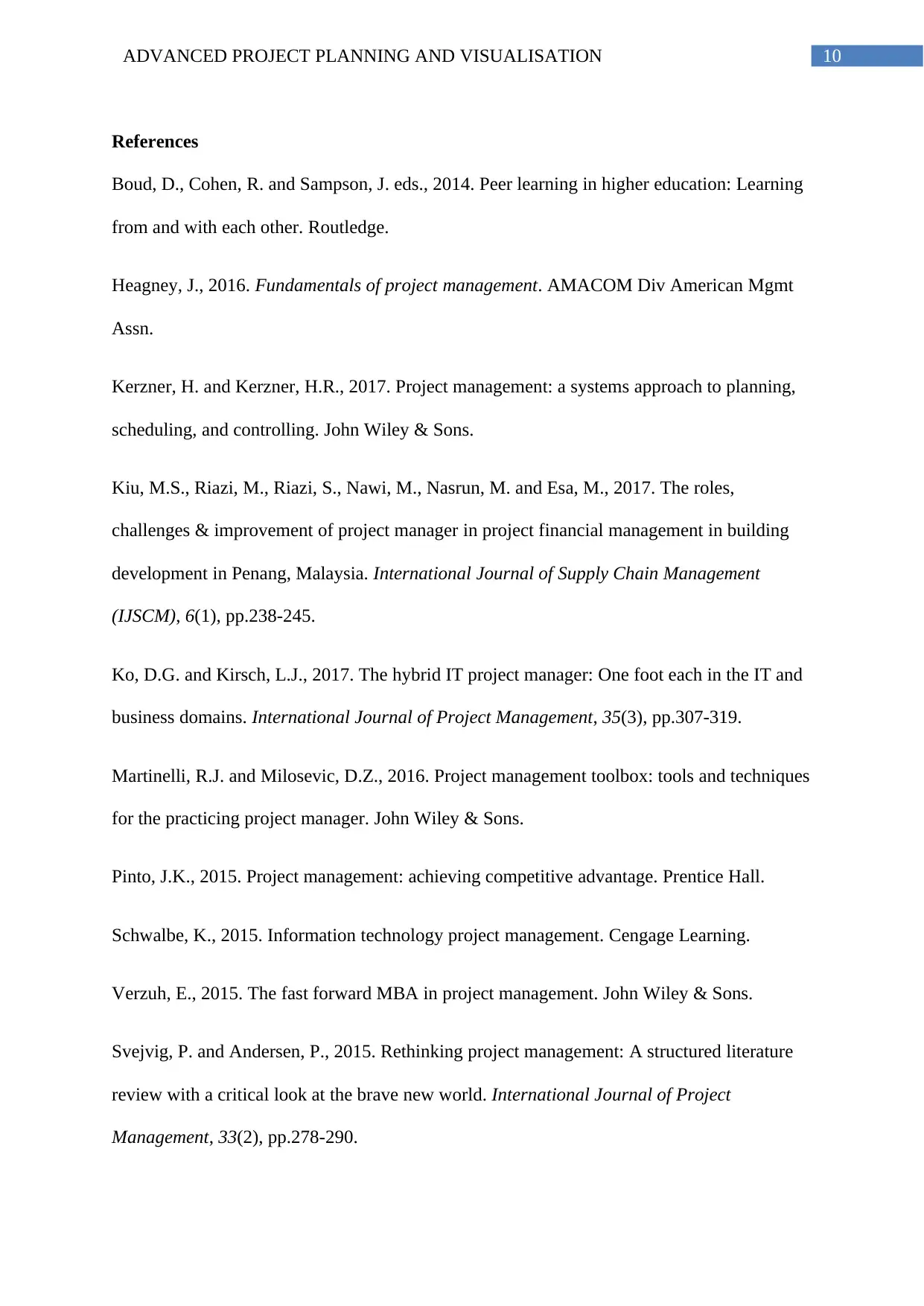
10ADVANCED PROJECT PLANNING AND VISUALISATION
References
Boud, D., Cohen, R. and Sampson, J. eds., 2014. Peer learning in higher education: Learning
from and with each other. Routledge.
Heagney, J., 2016. Fundamentals of project management. AMACOM Div American Mgmt
Assn.
Kerzner, H. and Kerzner, H.R., 2017. Project management: a systems approach to planning,
scheduling, and controlling. John Wiley & Sons.
Kiu, M.S., Riazi, M., Riazi, S., Nawi, M., Nasrun, M. and Esa, M., 2017. The roles,
challenges & improvement of project manager in project financial management in building
development in Penang, Malaysia. International Journal of Supply Chain Management
(IJSCM), 6(1), pp.238-245.
Ko, D.G. and Kirsch, L.J., 2017. The hybrid IT project manager: One foot each in the IT and
business domains. International Journal of Project Management, 35(3), pp.307-319.
Martinelli, R.J. and Milosevic, D.Z., 2016. Project management toolbox: tools and techniques
for the practicing project manager. John Wiley & Sons.
Pinto, J.K., 2015. Project management: achieving competitive advantage. Prentice Hall.
Schwalbe, K., 2015. Information technology project management. Cengage Learning.
Verzuh, E., 2015. The fast forward MBA in project management. John Wiley & Sons.
Svejvig, P. and Andersen, P., 2015. Rethinking project management: A structured literature
review with a critical look at the brave new world. International Journal of Project
Management, 33(2), pp.278-290.
References
Boud, D., Cohen, R. and Sampson, J. eds., 2014. Peer learning in higher education: Learning
from and with each other. Routledge.
Heagney, J., 2016. Fundamentals of project management. AMACOM Div American Mgmt
Assn.
Kerzner, H. and Kerzner, H.R., 2017. Project management: a systems approach to planning,
scheduling, and controlling. John Wiley & Sons.
Kiu, M.S., Riazi, M., Riazi, S., Nawi, M., Nasrun, M. and Esa, M., 2017. The roles,
challenges & improvement of project manager in project financial management in building
development in Penang, Malaysia. International Journal of Supply Chain Management
(IJSCM), 6(1), pp.238-245.
Ko, D.G. and Kirsch, L.J., 2017. The hybrid IT project manager: One foot each in the IT and
business domains. International Journal of Project Management, 35(3), pp.307-319.
Martinelli, R.J. and Milosevic, D.Z., 2016. Project management toolbox: tools and techniques
for the practicing project manager. John Wiley & Sons.
Pinto, J.K., 2015. Project management: achieving competitive advantage. Prentice Hall.
Schwalbe, K., 2015. Information technology project management. Cengage Learning.
Verzuh, E., 2015. The fast forward MBA in project management. John Wiley & Sons.
Svejvig, P. and Andersen, P., 2015. Rethinking project management: A structured literature
review with a critical look at the brave new world. International Journal of Project
Management, 33(2), pp.278-290.
Secure Best Marks with AI Grader
Need help grading? Try our AI Grader for instant feedback on your assignments.
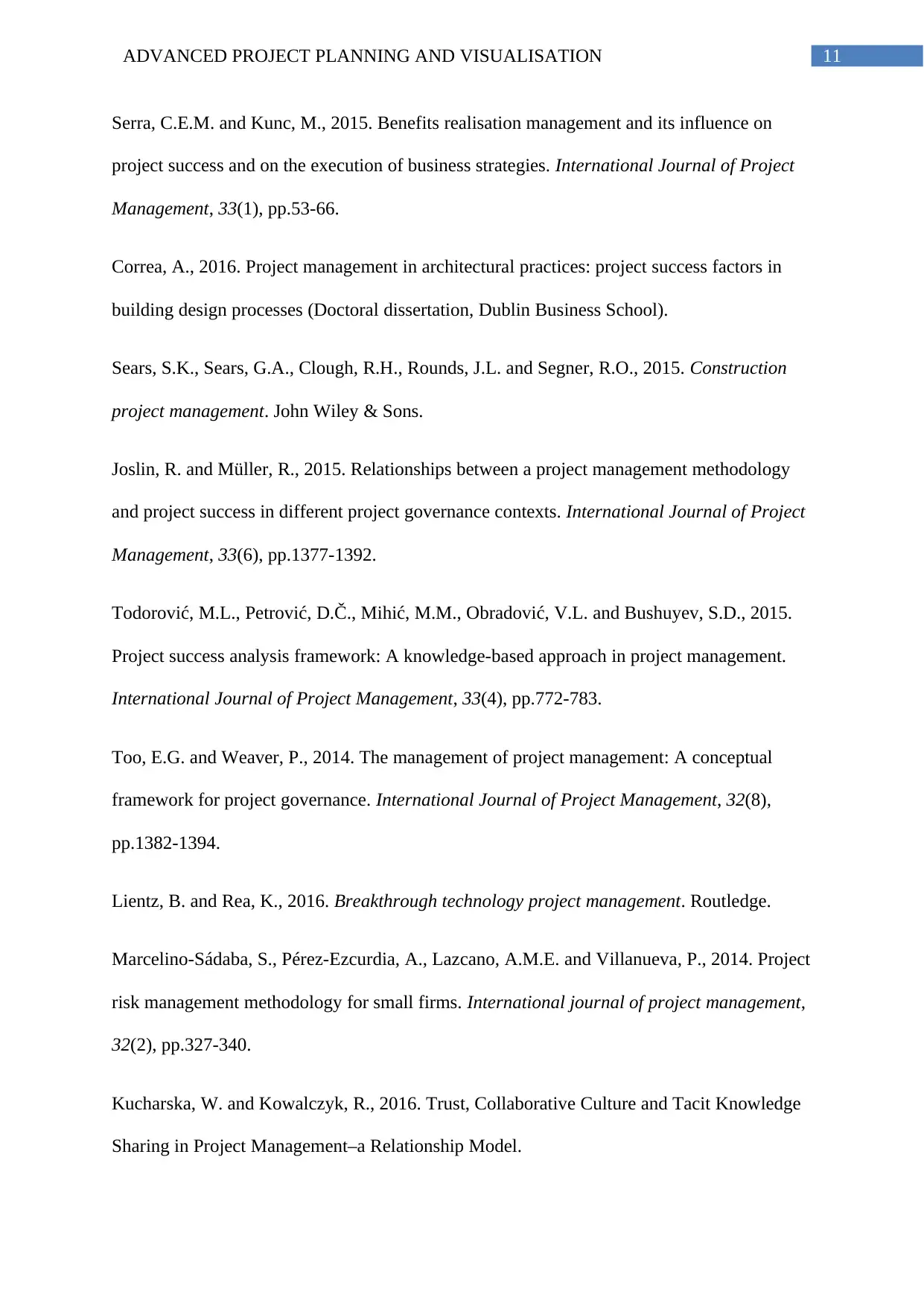
11ADVANCED PROJECT PLANNING AND VISUALISATION
Serra, C.E.M. and Kunc, M., 2015. Benefits realisation management and its influence on
project success and on the execution of business strategies. International Journal of Project
Management, 33(1), pp.53-66.
Correa, A., 2016. Project management in architectural practices: project success factors in
building design processes (Doctoral dissertation, Dublin Business School).
Sears, S.K., Sears, G.A., Clough, R.H., Rounds, J.L. and Segner, R.O., 2015. Construction
project management. John Wiley & Sons.
Joslin, R. and Müller, R., 2015. Relationships between a project management methodology
and project success in different project governance contexts. International Journal of Project
Management, 33(6), pp.1377-1392.
Todorović, M.L., Petrović, D.Č., Mihić, M.M., Obradović, V.L. and Bushuyev, S.D., 2015.
Project success analysis framework: A knowledge-based approach in project management.
International Journal of Project Management, 33(4), pp.772-783.
Too, E.G. and Weaver, P., 2014. The management of project management: A conceptual
framework for project governance. International Journal of Project Management, 32(8),
pp.1382-1394.
Lientz, B. and Rea, K., 2016. Breakthrough technology project management. Routledge.
Marcelino-Sádaba, S., Pérez-Ezcurdia, A., Lazcano, A.M.E. and Villanueva, P., 2014. Project
risk management methodology for small firms. International journal of project management,
32(2), pp.327-340.
Kucharska, W. and Kowalczyk, R., 2016. Trust, Collaborative Culture and Tacit Knowledge
Sharing in Project Management–a Relationship Model.
Serra, C.E.M. and Kunc, M., 2015. Benefits realisation management and its influence on
project success and on the execution of business strategies. International Journal of Project
Management, 33(1), pp.53-66.
Correa, A., 2016. Project management in architectural practices: project success factors in
building design processes (Doctoral dissertation, Dublin Business School).
Sears, S.K., Sears, G.A., Clough, R.H., Rounds, J.L. and Segner, R.O., 2015. Construction
project management. John Wiley & Sons.
Joslin, R. and Müller, R., 2015. Relationships between a project management methodology
and project success in different project governance contexts. International Journal of Project
Management, 33(6), pp.1377-1392.
Todorović, M.L., Petrović, D.Č., Mihić, M.M., Obradović, V.L. and Bushuyev, S.D., 2015.
Project success analysis framework: A knowledge-based approach in project management.
International Journal of Project Management, 33(4), pp.772-783.
Too, E.G. and Weaver, P., 2014. The management of project management: A conceptual
framework for project governance. International Journal of Project Management, 32(8),
pp.1382-1394.
Lientz, B. and Rea, K., 2016. Breakthrough technology project management. Routledge.
Marcelino-Sádaba, S., Pérez-Ezcurdia, A., Lazcano, A.M.E. and Villanueva, P., 2014. Project
risk management methodology for small firms. International journal of project management,
32(2), pp.327-340.
Kucharska, W. and Kowalczyk, R., 2016. Trust, Collaborative Culture and Tacit Knowledge
Sharing in Project Management–a Relationship Model.
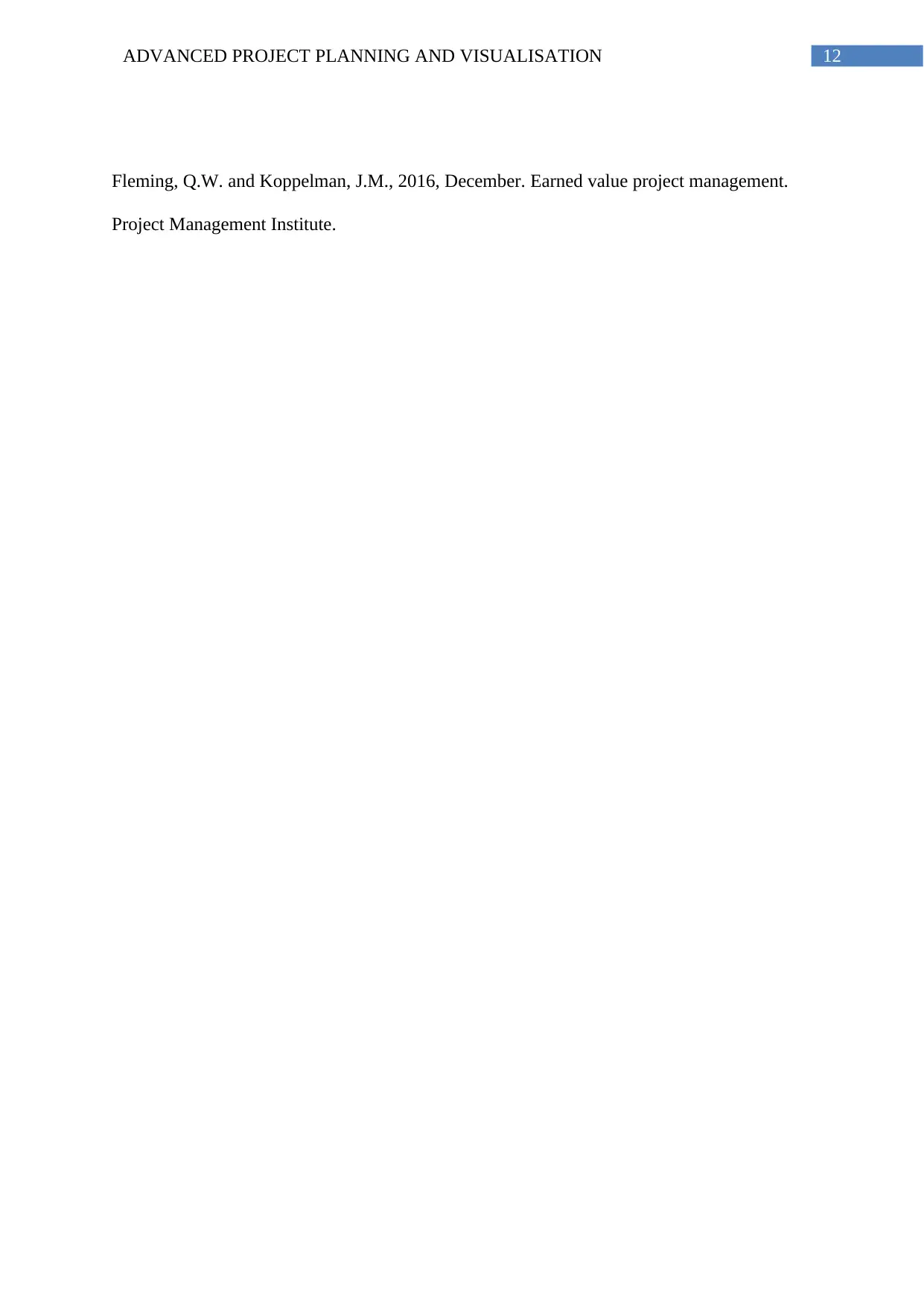
12ADVANCED PROJECT PLANNING AND VISUALISATION
Fleming, Q.W. and Koppelman, J.M., 2016, December. Earned value project management.
Project Management Institute.
Fleming, Q.W. and Koppelman, J.M., 2016, December. Earned value project management.
Project Management Institute.

13ADVANCED PROJECT PLANNING AND VISUALISATION
1 out of 13
Related Documents
Your All-in-One AI-Powered Toolkit for Academic Success.
+13062052269
info@desklib.com
Available 24*7 on WhatsApp / Email
![[object Object]](/_next/static/media/star-bottom.7253800d.svg)
Unlock your academic potential
© 2024 | Zucol Services PVT LTD | All rights reserved.



